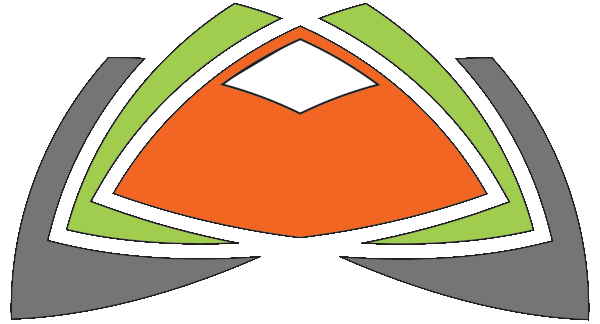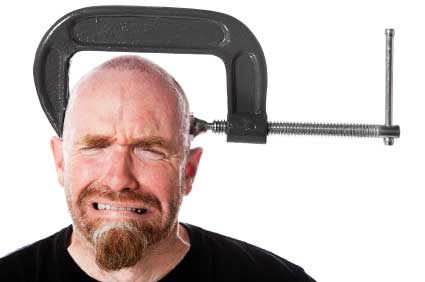Medical research has shown that 70% of all headaches are related to the joints and muscles in your neck.
Headaches can occur because of pain coming from any muscle, ligament, disc, or joint in the head or neck. There are well mapped out patterns of headaches relating to muscular trigger points in the neck and shoulder-blade region, as well as to disc and joint levels in the upper cervical spine. Even headaches located predominantly in the forehead, or behind, in and around the eyes are very often “referred” pain zones from pathology(problem spots) located in the back of the neck and at the base of the skull. These problems can arise from direct injury to the head and neck or more commonly, just the overuse of the muscles and joints from everyday postures (e.g. sitting all day at a desk). Our bodies were not designed for all the excessive positions we put them in every day.
Headache Description
Headaches can occur because of pain coming from any muscle, ligament, disc, or joint in the head or neck. There are well mapped out patterns of headaches relating to muscular trigger points in the neck and shoulder-blade region, as well as to disc and joint levels in the upper cervical spine. Even headaches located predominantly in the forehead, or behind, in and around the eyes are very often “referred” pain zones from pathology(problem spots) located in the back of the neck and at the base of the skull. These problems can arise from direct injury to the head and neck or more commonly, just the overuse of the muscles and joints from everyday postures (e.g. sitting all day at a desk). Our bodies were not designed for all the excessive positions we put them in every day.
Treatment Considerations:
Published research on headaches has shown chiropractic to be very successful in the treatment of most headache types including: cervicogenic, tension, migraine, sinus, TMD (jaw), trauma (e.g whiplash) and chronic headaches. This research has shown chiropractic treatment to be just as effective as standard headache medication. Both treatments demonstrated that the headache intensity, duration, and OTC drug usage were all significantly decreased. However, four weeks following treatment, the patients who had taken medication for their headaches returned to their pre-treatment headache status, whereas the majority of those treated with spinal manipulation (chiropractic) maintained their level of improvement. Whether your headache is new or ongoing, throbbing or constant, severe or mild – chiropractic can help.
Chiropractic adjustments Massage/ Muscle energy techniques/ topical muscle creams
Stretching exercises
Postural retraining
Aerobic exercise
Ergonomic advice for work/ sleep/ activities/ exercise
Stress management
Progressive Relaxation Exercises/ breathing techniques
Yoga
Supplements
Diet modification
Stretching exercises for headaches
should be relaxing. They should be done daily, with each session lasting about 25 minutes. Stretches should produce a normal sensation of stretching but not pain. Hold the stretch for 10-20 seconds, relax for 5-10 seconds, and then repeat each stretch about 3-5 times. Many stretching exercises can be performed while standing or sitting and can act as stress releasers when sitting at a long meeting or in the car, waiting in line at the store, or standing in the shower. Many people schedule their stretching exercises with their favorite daily television program to increase the likelihood that they will make these exercises part of their daily routine; others use them before bed to aid sleep.
• Neck range of motion: Bend your chin to your chest, then rotate chin to each shoulder; tip your ear toward your shoulder, then pull in your chin to make a double chin.
• Shoulder shrugs: Sit/stand up straight and raise your shoulders straight up. Lower and relax. Then raise shoulders up and forward. Lower and relax. Then raise shoulders up and back.
• Suboccipital range of motion: Place a rolled or folded towel behind your neck and gently pull down. Tilt your chin to your chest. Look up at the ceiling. Tilt your ear toward the shoulder.
• Neck stretches: Tilt your ear to the shoulder on the same side. Then tilt your chin forward and toward the opposite breast. Gently press with your hand at the end of the stretch to feel the stretch.
• Neck isometrics: Place your palm on your forehead and press your head against it, keeping your palm stationary. Don t let the head or hand move. Repeat with your hand on each side of the head.
• Chin tucks: Laying face up, bring your chin to your chest. Repeatedly flex your head forward making a double chin. Your jaw and head shouldn’t move up and down more than an inch.
• Head lift: Place folded hands behind the neck at the base of your head. Pull elbows forward and up to achieve the sensation of lifting the head up slightly from the neck.
• Turtle: With head looking forward, push the chin forward, away from the neck. When the head is forward, turn about 1 inch to each side and up.
* Consult with your doctor before changing your diet.
Foods to REMOVE from your diet (If you can rule out these triggers, there’s
no need to avoid them)
1. Ripened cheeses: Cheddar, Swiss, Provolone, Romano, Emmantaler, Gruyere, Stilton, Brie, Camembert
2. Caffeine, chocolate, cocoa, white chocolate, licorice
3. Nuts, especially peanuts, peanut butter, pumpkin, sesame, and sunflower seeds
4. Avocados, papaya, red plums, fresh pineapple, raisins, canned figs, banana
5. Milk, eggs, sour cream, yogurt, buttermilk, and all dairy products
6. Hot fresh breads, raised coffeecakes, and doughnuts
7. Corn, tomatoes, olives, pickles, sauerkraut, onions (except for seasoning)
8. Broad beans, lima beans, navy beans, pea pods, pinto beans, soybeans, and snow peas
9. Aged or cured meats: hot dogs, ham, bacon, bologna, chicken liver, pork; fermented sausage: salami, pepperoni
10. Soy sauce, yeast, yeast extract, brewers yeast, Accent seasoned salt, meat tenderizer, MSG
11. Citrus fruits: oranges, grapefruit, pineapples, lemons, limes
12. Passion fruits: kiwis, strawberries, mangos and papayas
13. Salted and dried fish, herring, snails
14. Vinegar (except white vinegar)
15. Pizza
16. Wheat products
17. Anything fermented, pickled, or marinated
18. All alcoholic beverages. If you must drink, do not exceed more than two drinks
19. Shellfish
20. Fasting
21. Aspartame (NutriSweet)
22. Nicotine
View Larger Map

